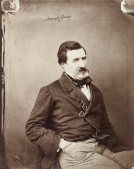Champfleury (1821-1889) as a ragpicker
Félix Nadar, around 1853
Drawing not included in Nadar's Pantheon: caricature from the "Nadar's Contemporaries" series published in the March 5, 1859 edition of Le Journal amusant
Charcoal drawing on brown paper with white-gouache highlights, 31 x 23.3 cm.
BnF, Prints and Photographs Department, STORAGE NA-88-ÉCU BOX
© Bibliothèque nationale de France
Champfleury was the pseudonym of Jules Félix François Husson, a.k.a. Fleury. When Nadar’s Pantheon was released, Champfleury’s name was in the news. He had recently published several volumes, pantomimes, and a triptych: Chien-Caillou (Pebble-Dog), Feu Miette (Crumb Fire) and Pauvre trompette (Poor Trumpet, 1847); a novel about Bohemian life, Les Aventures de Mademoiselle Mariette (1853), as well as an essay that helped establish his reputation, Les Excentriques (1852). A fan of Balzac’s work, he had been rubbing shoulders with Courbet at the Brasserie Andler for quite some time, and defended a new esthetic: Realism. His fame came essentially from the press, and he contributed to a great many newspapers. His social climbing and his scission from the Bohemians often led him and Nadar into conflict. Nevertheless, a few years later, Nadar dedicated his Mémoires du Géant (Memoirs of Le Géant): "To my old comrade Chien Fleury (a.k.a. Chien Caillou).”
Yet relations between Félix Nadar and Champfleury had never actually been very cordial: in fact, they nearly had a duel in 1848. An advocate of realism in both painting and literature, Champfleury is portrayed as a ragpicker: basket on back and hook in hand, rummaging through the rubbish at the foot of a boundary stone. Nadar was illustrating a common criticism of the Realist school, namely that they looked for their subjects amidst mud and muck, at the expense of ideals and moral elevation.
Yet relations between Félix Nadar and Champfleury had never actually been very cordial: in fact, they nearly had a duel in 1848. An advocate of realism in both painting and literature, Champfleury is portrayed as a ragpicker: basket on back and hook in hand, rummaging through the rubbish at the foot of a boundary stone. Nadar was illustrating a common criticism of the Realist school, namely that they looked for their subjects amidst mud and muck, at the expense of ideals and moral elevation.
Images liées
© BnF, Éditions multimédias, 2018
